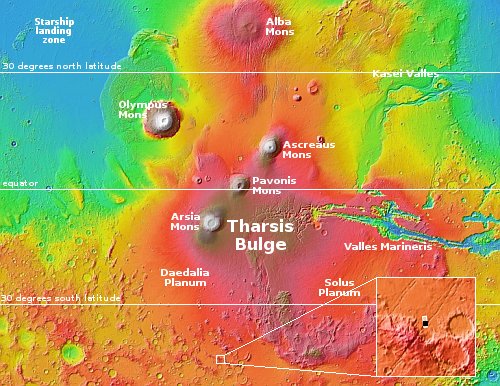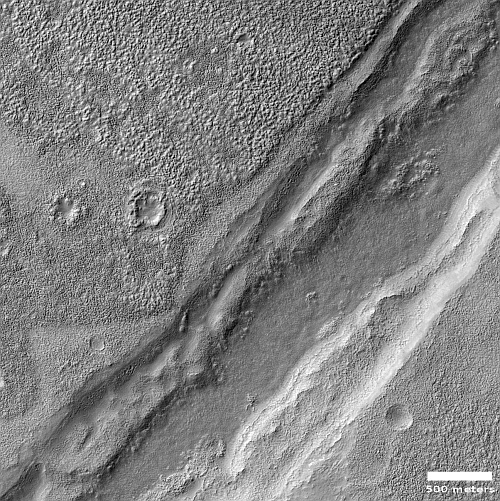Ice-filled fissure on Mars?
Cool image time! The picture to the right, cropped, reduced, and sharpened to post here, was taken on February 15, 2023 by the high resolution camera on Mars Reconnaissance Orbiter (MRO). The science team labeled this a “Terrain Sample”, which suggests but doesn’t guarantee that it was to fill a gap in the camera’s schedule in order to maintain that camera’s proper temperature, and therefore was targeted at a relatively random but potentially interesting location.
What we see is a fissure canyon, about 250 to 300 feet deep with cliffs about 125 high, that appears surrounded and even filled with icelike features. Even the craters on the plateau above the canyon appear like they either impacted in ice, or have since been filled and eroded by that ice.
But is it ice?

The black dot inside the inset on the overview map to the right marks this location. At 41 degrees south latitude, it would not be surprising if MRO captured a fissure at this latitude filled with ice. Nor would it be surprising if the plains above that fissure also showed evidence of a near-surface ice sheet. This picture shows evidence of both, with the bumpy look to the ice sheets suggesting some sublimation process causing that ice sheet to become deformed in this manner.
The fissure itself appears to be a crack caused by the rise of the Tharsis Bulge, the lava flood plain on Mars where three of the planet’s biggest shield volcanoes are located. This crack is near the southern fringe of Tharsis. In the inset you can see a second parallel fissure to the northwest, also likely created by the rise of that bulge.
This picture once again strengthens the hypothesis that Mars is an icy planet, a desert more like Antarctica than the Sahara. The closer to the poles you get, the more likely every image will invoke evidence of ice.
On Christmas Eve 1968 three Americans became the first humans to visit another world. What they did to celebrate was unexpected and profound, and will be remembered throughout all human history. Genesis: the Story of Apollo 8, Robert Zimmerman's classic history of humanity's first journey to another world, tells that story, and it is now available as both an ebook and an audiobook, both with a foreword by Valerie Anders and a new introduction by Robert Zimmerman.
The print edition can be purchased at Amazon or from any other book seller. If you want an autographed copy the price is $60 for the hardback and $45 for the paperback, plus $8 shipping for each. Go here for purchasing details. The ebook is available everywhere for $5.99 (before discount) at amazon, or direct from my ebook publisher, ebookit. If you buy it from ebookit you don't support the big tech companies and the author gets a bigger cut much sooner.
The audiobook is also available at all these vendors, and is also free with a 30-day trial membership to Audible.
"Not simply about one mission, [Genesis] is also the history of America's quest for the moon... Zimmerman has done a masterful job of tying disparate events together into a solid account of one of America's greatest human triumphs."--San Antonio Express-News
Cool image time! The picture to the right, cropped, reduced, and sharpened to post here, was taken on February 15, 2023 by the high resolution camera on Mars Reconnaissance Orbiter (MRO). The science team labeled this a “Terrain Sample”, which suggests but doesn’t guarantee that it was to fill a gap in the camera’s schedule in order to maintain that camera’s proper temperature, and therefore was targeted at a relatively random but potentially interesting location.
What we see is a fissure canyon, about 250 to 300 feet deep with cliffs about 125 high, that appears surrounded and even filled with icelike features. Even the craters on the plateau above the canyon appear like they either impacted in ice, or have since been filled and eroded by that ice.
But is it ice?

The black dot inside the inset on the overview map to the right marks this location. At 41 degrees south latitude, it would not be surprising if MRO captured a fissure at this latitude filled with ice. Nor would it be surprising if the plains above that fissure also showed evidence of a near-surface ice sheet. This picture shows evidence of both, with the bumpy look to the ice sheets suggesting some sublimation process causing that ice sheet to become deformed in this manner.
The fissure itself appears to be a crack caused by the rise of the Tharsis Bulge, the lava flood plain on Mars where three of the planet’s biggest shield volcanoes are located. This crack is near the southern fringe of Tharsis. In the inset you can see a second parallel fissure to the northwest, also likely created by the rise of that bulge.
This picture once again strengthens the hypothesis that Mars is an icy planet, a desert more like Antarctica than the Sahara. The closer to the poles you get, the more likely every image will invoke evidence of ice.
On Christmas Eve 1968 three Americans became the first humans to visit another world. What they did to celebrate was unexpected and profound, and will be remembered throughout all human history. Genesis: the Story of Apollo 8, Robert Zimmerman's classic history of humanity's first journey to another world, tells that story, and it is now available as both an ebook and an audiobook, both with a foreword by Valerie Anders and a new introduction by Robert Zimmerman.
The print edition can be purchased at Amazon or from any other book seller. If you want an autographed copy the price is $60 for the hardback and $45 for the paperback, plus $8 shipping for each. Go here for purchasing details. The ebook is available everywhere for $5.99 (before discount) at amazon, or direct from my ebook publisher, ebookit. If you buy it from ebookit you don't support the big tech companies and the author gets a bigger cut much sooner.
The audiobook is also available at all these vendors, and is also free with a 30-day trial membership to Audible.
"Not simply about one mission, [Genesis] is also the history of America's quest for the moon... Zimmerman has done a masterful job of tying disparate events together into a solid account of one of America's greatest human triumphs."--San Antonio Express-News


